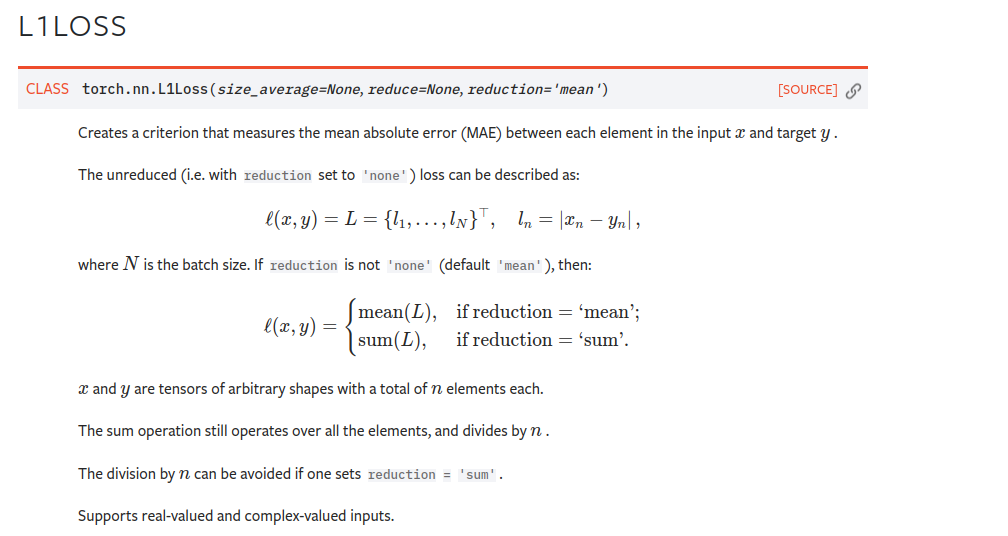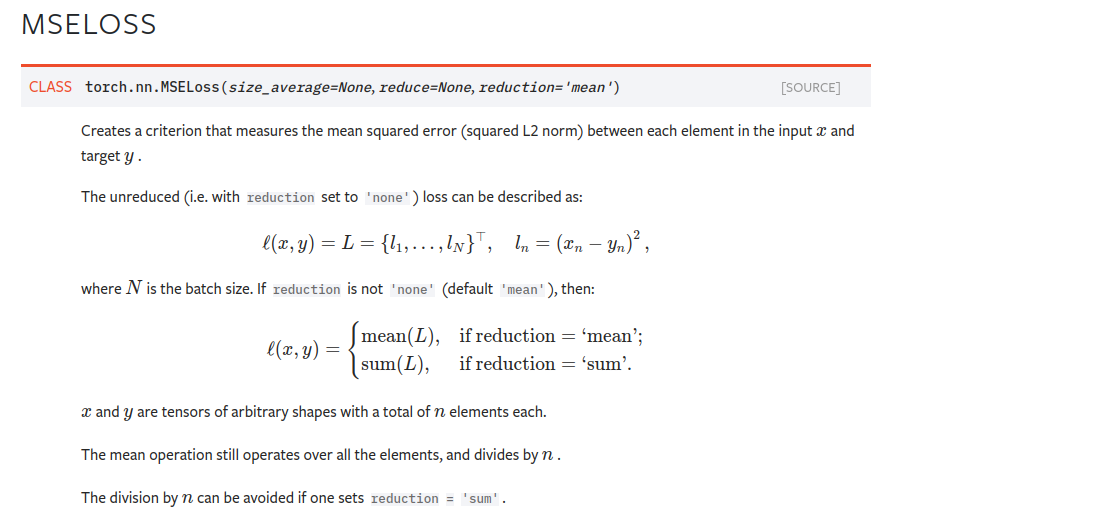pytorch学习笔记(9)--损失函数
1、损失函数的作用:
(1)计算实际输出和目标输出之间的差距;
(2)为我们更新输出提供一定的依据(也就是反向传播)
官网链接:https://pytorch.org/docs/1.8.1/nn.html
2、损失函数的使用
2.1、L1Loss

注:reduction = “sum” 表示求和 / reduction = "mean" 表示求平均值 默认求平均值
代码:
# file : nn_lose.py # time : 2022/8/2 上午10:31 # function : L1Loss import torch from torch.nn import L1Loss from torch import nn inputs = torch.tensor([1, 2, 3], dtype=torch.float32) targets = torch.tensor([1, 2, 5], dtype=torch.float32) # reshape()添加维度,原来tensor是二维 inputs = torch.reshape(inputs, (1, 1, 1, 3)) targets = torch.reshape(targets, (1, 1, 1, 3)) loss = L1Loss() result = loss(inputs, targets) print(result)
上述代码计算了实际输出[1, 2, 3]和目标输出[1, 2, 5]之间的L1Loss,代码输出结果为:
tensor(0.6667)
2.2MSELoss 均方损失函数:可以设置reduction参数来决定具体的计算方法

代码:
# file : nn_lose.py # time : 2022/8/2 上午10:31 # function : import torch from torch.nn import L1Loss from torch import nn inputs = torch.tensor([1, 2, 3], dtype=torch.float32) targets = torch.tensor([1, 2, 5], dtype=torch.float32) # reshape inputs = torch.reshape(inputs, (1, 1, 1, 3)) targets = torch.reshape(targets, (1, 1, 1, 3)) loss = L1Loss(reduction="sum") result = loss(inputs, targets) print(result) # MSELoss 均方损失函数 loss_mse = nn.MSELoss(reduction="sum") result_mse = loss_mse(inputs, targets) print(result_mse)
结果:tensor(2.)
tensor(4.) #均方误差损失函数计算结果
2.3 CrossEntropyLoss交叉熵损失函数----没懂
交叉熵损失函数计算方法的细节可以参照这个博文:交叉熵损失函数。(看上去很牛)
代码:
# file : nn_lose.py # time : 2022/8/2 上午10:31 # function : import torch from torch.nn import L1Loss from torch import nn inputs = torch.tensor([1, 2, 3], dtype=torch.float32) targets = torch.tensor([1, 2, 5], dtype=torch.float32) # reshape inputs = torch.reshape(inputs, (1, 1, 1, 3)) targets = torch.reshape(targets, (1, 1, 1, 3)) loss = L1Loss(reduction="sum") result = loss(inputs, targets) print(result) # MSELoss 均方损失函数 loss_mse = nn.MSELoss(reduction="sum") result_mse = loss_mse(inputs, targets) print(result_mse) # CrossEntropyLoss x = torch.tensor([0.1, 0.2, 0.3]) y = torch.tensor([1]) x = torch.reshape(x, (1, 3)) loss_cross = nn.CrossEntropyLoss() result_cross = loss_cross(x, y) print(result_cross)
结果:tensor(1.1019)
用了之前的一个简单神经网络,测试了损失函数及反向传播
# file : nn_loss_network.py # time : 2022/8/2 下午2:39 # function : import torch import torchvision.datasets from torch import nn from torch.nn import Conv2d, MaxPool2d, Flatten, Linear, Sequential from torch.utils.data import DataLoader dataset = torchvision.datasets.CIFAR10("../dataset", train=False, transform=torchvision.transforms.ToTensor(), download=False) dataloader = DataLoader(dataset, batch_size=1) class Tudui(nn.Module): def __init__(self): super(Tudui, self).__init__() self.model1 = Sequential( Conv2d(3, 32, 5, padding=2), MaxPool2d(2), Conv2d(32, 32, 5, padding=2), MaxPool2d(2), Conv2d(32, 64, 5, padding=2), MaxPool2d(2), Flatten(), Linear(1024, 64), Linear(64, 64) ) def forward(self, x): x = self.model1(x) return x loss = nn.CrossEntropyLoss() tudui = Tudui() for data in dataloader: imgs, targets = data outputs = tudui(imgs) result_loss = loss(outputs, targets) result_loss.backward() print("ok")







 浙公网安备 33010602011771号
浙公网安备 33010602011771号